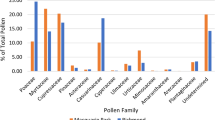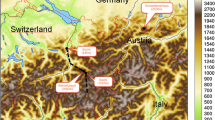Abstract
Raindrops brim with pollen even when there is no ambient local pollen. How does this nonlocal pollen get inside rain? The likely answer is long-range transport beneath or inside clouds. To test this hypothesis, we captured rain-delivered pollen on Ocracoke Island, NC, USA over a 12-day interval before local pine pollen release then reconstructed its trajectory and its atmospheric exposure conditions. Findings were as follows: four rain episodes yielded a total of 632 pollen grains of which 6.7% germinated. To find pollen sources, we first identified pollen-releasing forested areas using a predictive heat sum equation for each rain episode. Next, we constructed the backward trajectory for air parcels carrying rain-delivered pollen from those forests using the MLDP atmospheric transport and dispersion model. Nonlocal sources were located at distances up to 300 km from Ocracoke Island and distances lessened with each successive episode. Below-cloud transport time was 8 and 17 h for Episodes A and B, respectively. Pollen grains were exposed to harsh atmospheric conditions during below-cloud transport, yet some grains still germinated. Atmospheric turbulence patterns changed for each episode, so distance from pollen source was poorly correlated with pollen transport time. Pollen germination was not closely correlated with either distances or transport time. In-cloud transport was more likely for pollen sampled during Episodes C and D. Pine pollen, although rarely allergenic, brings fresh insights into how atmospheric events can trigger human respiratory distress.





Source receptor sensitivity (SRS) for Episode A on (a) April 1, 2013, at 00UTC, (b) March 31 at 22UTC, and for Episode B on (c) April 3 at 06UTC, and (d) April 2 at 22UTC. Panels (e) and (f) show the Lagrangian particle heights for (e) Episode C on April 4 at 22UTC and (f) Episode D on April 12 at 18UTC. Ocracoke Island pollen sampling locations (gray dot), weather stations providing data for the heat sum model (triangles) and P. taeda range (black bold line) are also shown

source areas of Waccamaw National Wildlife Refuge, SC (Episode A) and Cape Fear River Basin, NC (Episode B). The polygons depict the areas considered for the source regions


Similar content being viewed by others
Notes
This is expressed on Eastern Standard Time. If expressed on UTC, then sampling took place on Julian dates would be 91, 93, 94, 95 and 102.
References
Al-Rabab’ah, M. and C.G. Williams. . (2002). Population dynamics of Pinus taeda L. based on nuclear microsatellites. Forest Ecology and Management, 163, 263–271.
Andrew, E., et al. (2017). Stormy weather: a retrospective analysis of demand for emergency medical services during epidemic thunderstorm asthma. The BMJ, 359, j5636. https://doi.org/10.1136/bmj.j536.
Aylor, D. E. (2003). Spread of plant diseases on a continental scale: Role of aerial dispersal of pathogens. Ecology, 84, 1989–1997.
Aylor, D. E., Taylor, G. S., & Raynor, G. S. (1982). Long-range transport of tobacco blue mold spores. Agricultural Meteorology, 27, 217–232.
Blush T. 1986. Seasonal and diurnal patterns of pollen flight in a loblolly seed orchard. IUFRO Proceedings, Williamsburg VA. pp 150–159.
Bohrerova, Z., Bohrer, G., Cho, K.-D., Bolch, M. A., & Linden, K. G. (2009). Determining the viability response of pine pollen to atmospheric conditions during long-distance dispersal. Ecological Applications, 19, 656–667.
Boyer, W. D. (1978). Heat accumulation: An easy way to anticipate the flowering of southern pines. Journal of Forestry, 76, 20–23.
Bunderson, L. D., & Levetin, E. (2015). Hygroscopic weight gain of pollen grains from Juniperus species. Int. J. of Biometeorology, 59, 533–540.
Busse, J. (1926). Kiefernpollenflug und Fortsliche Saatgutanerkennung. Tharandt. Forstl. Jb., 77, 225–231.
Cambon, G., Ritchie, J. C., & Guinet, P. (1992). Pollen marqueur de transports á longue distance dans l’atmosphère du sud de l’Ontario (Canada). Canadian Journal of Botany, 70, 2284–2293.
Campbell, I. D., McDonald, K., Flanigan, M. D., & Kringayark, J. (1999). Long-distance transport of pollen into the Arctic. Nature, 399, 29–30.
Caron, J.-F., Milewski, T., Buehner, M., Fillion, L., Reszka, M., Macpherson, S., et al. (2015). Implementation of deterministic weather forecasting systems based on ensemble-variational data assimilation at environment Canada, part II: The regional system. Monthly Weather Review, 143(7), 2560–2580.
Chen, L., Chen, Y., Chen, L., Gu, W., Peng, C., Luo, S., et al. (2019). Hygroscopic properties of 11 pollen species in China. ACS Earth and Space Chemistry, 3(12), 2678–2683.
Côté, J., Desmarais, J.-G., Gravel, S., Méthot, A., Patoine, A., Roch, M., & Staniforth, A. (1998b). The operational CMC-MRB global environmental multiscale (GEM) model: Part II – results. Monthly Weather Review, 126, 1397–1418.
Côté, J., Gravel, S., Méthot, A., Patoine, A., Roch, M., & Staniforth, A. (1998a). The operational CMC-MRB global environmental multiscale (GEM) model: Part I - design considerations and formulation. Monthly Weather Review, 126, 1373–1395.
D’Amours, R., Malo, A., Flesch, T., Wilson, J., Gauthier, J.-P., & Servranckx, R. (2015). The Canadian meteorological centre’s atmospheric transport and dispersion modelling suite. Atmosphere-Ocean, 53(2), 176–199.
Diehl, K., Quick, C., Matthias-Maser, S., Mitra, S., & Jaenicke, R. (2001). The ice-nucleating ability of pollen. Part I: Laboratory studies in deposition and condensation freezing modes. Atmospheric Research, 58, 75–87.
Draxler, R. R., & Rolph, G. D. (2012). Evaluation of the Transfer coefficient matrix (TCM) approach to model the atmospheric radionuclide air concentrations from Fukushima. Journal of Geophysical Research: Atmospheres. https://doi.org/10.1029/2011JD017205.
Forster, C., Stohl, A., & Seibert, P. (2007). Parameterization of convective transport in a Lagrangian particle dispersion model and its evaluation. Journal of Applied Meteorology and Climatology, 46(4), 403–422.
Fröhlich-Nowoisky, J., Kampf, C. J., Weber, B., Huffman, J. A., Pöhlker, C., Andreae, M. O., et al. (2016). Bioaerosols in the earth system: Climate, health and ecosystem interactions. Atmospheric Research, 182, 346–376.
Gregory, P. H. (1961). The microbiology of the atmosphere (p. 251). Plant Science Monographs: Leonard Hill Books, London.
Grundstein, A., Shepherd, M., & P. Miller an S.E. Sarnat. . (2017). The role of mesoscale-convective processes explaining the 21 November 2016 epidemic thunderstorm asthma event in Melbourne Australia. Journal of Applied Meteorology and Climatology, 56, 1337–1343.
Hader, J. D., Wright, T. P., & Petters, M. D. (2014). Contribution of pollen to atmospheric ice nuclei concentrations. Atmospheric Chemistry and Physics, 14, 5433–5449.
Hjelmroos, M. (1991). Evidence of long-distance transport of Betula pollen. Grana, 30, 215–228.
Isard, S.A. and Gage, S.A. 2001. Flow of Life in the Atmosphere. Michigan State University Press 240 p.
Jaenicke, R. (2005). Abundance of cellular material and proteins in the atmosphere. Science, 308, 73.
Katul, G. G., Williams, C. G., Siqueira, M., Poggi, D., Porporato, A., McCarthy, H., & Oren, R. (2006). Dispersal of transgenic conifer pollen. In C. G. Williams (Ed.), Landscapes, Genomics and Transgenic Conifers (pp. 121–143). Dordrecht Netherlands: Springer Press.
Knox, R. B. (1993). Grass pollen, thunderstorms and asthma. Clinical and Experimental Allergy, 23, 354–359.
Lanner, R. M. (1966). Needed: A new approach to the study of pollen dispersion. Silvae Genetica, 15, 50–52.
Mandrioli, P., Grazia, M., Negrini, G., Cesari, G., & Morgan, G. (1984). Evidence for long-range transport of biological and anthropogenic aerosol parts in the atmosphere. Grana, 23, 43–53.
Marks, G. B., et al. (2001). Thunderstorm outflows preceding epidemics of asthma during spring and summer. Thorax, 56, 468–471.
Marks, G. B., & Bush, R. K. (2007). It’s blowing in the wind: new insights into thunderstorm-related asthma. The Journal of Allergy and Clinical Immunology, 120, 530–532.
McDonald, J. E. (1962). Collection and washout of airborne pollens and spores by raindrops. Science, 135, 435–437.
Miquel, P. 1883. Les organismes vivants de l’atmosphère. Guthier–Villars, Paris. 342 p. https://ia601403.us.archive.org/14/items/lesorganismesviv00miqurich/lesorganismesviv00miqurich.pdf (accessed 4/27/16)
Mohanty, R. P., Buchhaim, M. A., Anderson, J., & Levetin, E. (2017). Molecular analysis confirms the long-distance transport of Juniperus ashei pollen. PLoS ONE, 12(3), e0173465.
Pardi, M. L. L., Viegi, G. C., Renzoni, G. G. F., & Pacini, E. (1996). Effects of acidity on the insoluble polysaccharide content of germinating pollen on Pinus pinea L. and Pinus pinaster Aiton. Grana, 35, 240–247.
Prasad, A. M. and L. R. Iverson. 2003. Little's range and FIA importance value database for 135 eastern US tree species. http://www.fs.fed.us/ne/delaware/4153/global/littlefia/index.html, Northeastern Research Station, USDA Forest Service, Delaware, Ohio.
Pummer, B. G., Bauer, H., Bernardi, J., Bleicher, S., & Grothe, H. (2012). Suspendable macromolecules are responsible for ice nucleation activity of birch and conifer pollen. Atmospheric Chemistry and Physics, 12, 2541–2550.
Raynor, G. S., Hayes, J. V., & Lewis, D. M. (1983). Testing of the Air Resources Laboratories trajectory model on cases of pollen wet deposition after long-distance transport from known source regions. Atmospheric Environment, 17(2), 213–220.
Raynor, G. S., Hayes, J. V., & Ogden, E. C. (1974). Mesoscale transport and dispersion of airborne pollens. Journal of Applied Meteorology, 13(1), 87–95.
Robichaud, A., & Comtois, P. (2019). Environmental factors and asthma hospitalization in Montreal, Canada, during spring 2006–2008: A synergy perspective. Air Quality, Atmosphere & Health, 12, 1495–1509.
Sassen, K. (2008). Boreal tree pollen sensed by polarization lidar: Depolarizing biogenic chaff. Geophysical Research Letters, 35, L18810. https://doi.org/10.1029/2008GL035085.
Schwendemann, A., Wang, G., Mertz, M., McWilliams, R., Thatcher, S., & Osborn, J. (2007). Aerodynamics of saccate pollen and its implications for wind pollination. American Journal of Botany, 94(8), 1371–1381.
Steiner, A. L., Brooks, S. D., Deng, C., Thornton, D. C. O., Pendelton, M. W., & Bryant, V. (2015). Pollen as atmospheric cloud condensation nuclei. Geophysical Research Letters, 42, 3596–3602.
Taylor, P. E., & Jonsson, H. (2004). Thunderstorm asthma. Curr. Allergy & Asthma Reports, 4, 409–413.
Westbrook, J. K., & Isard, S. A. (1999). Atmospheric scales of biotic dispersal. Agricultural and Forest Meteorology, 97, 263–274.
Williams, C. G. (2008). Aerobiology of Pinus taeda pollen clouds. Canadian Journal of Forest Research, 38, 2177–2188.
Williams, C. G. (2009). Conifer reproductive biology (p. 169). Berlin: Springer Publishers.
Williams, C. G. (2010). Long-distance pine pollen still germinates after meso-scale dispersal. American Journal of Botany, 97, 1–11.
Williams, C. G. (2013). Forest tree pollen dispersal via the water cycle. American Journal of Botany, 100(6), 1184–1190.
Williams, C. G. (2020). Atmospheric layering during peak pine pollen season. Grana, 59(2/3), 1–10. https://doi.org/10.1080/00173134.2020.1737728.
Williams, C. G., & Després, V. (2017). Temperate forests are a major pollen contributor to seasonal biogenic emissions. Forest Ecology & Management, 401, 1987–2191.
Williams, C. G., & von Aderkas, P. (2011). Marking live conifer pollen for long-distance dispersal experiments. Oecologia, 165, 249–254.
Wotawa, G., Geer, L.-E., Denier, P., Kalinowski, M., Toivonen, H., D’Amours, R., et al. (2003). Atmospheric transport modelling in support of CTBT verification–overview and basic concepts. Atmos. Env., 37(18), 2529–2537.
Acknowledgements
Special thanks to F. Bridgwater at USDA-Forest Service; to M Greenwood at University of Maine; and to Dov Bensimon and Alain Malo from Environment and Climate Change Canada for their comments and suggestions reviewing this paper.
Author information
Authors and Affiliations
Corresponding author
Rights and permissions
About this article
Cite this article
Williams, C.G., Barnéoud, P. Live pine pollen in rainwater: reconstructing its long-range transport. Aerobiologia 37, 333–350 (2021). https://doi.org/10.1007/s10453-021-09697-5
Received:
Accepted:
Published:
Issue Date:
DOI: https://doi.org/10.1007/s10453-021-09697-5




